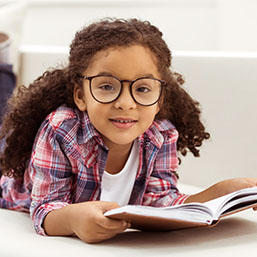
\n
Raising a lifelong reader is not a simple process. The foundation for literacy skills begins at birth and caregivers can build their child’s skills early through daily reading, singing, and talking. To crack the code of reading, children need direct instruction on phonics (learning which letters match the sounds), lots of practice, and support. But how do parents engage reluctant readers who are not interested in reading and aren’t excited about opening a book?
\n \nMany children groan when it is time to read or insist on reading the same comic book for the fifteenth time. Encouraging a love of reading can feel like a guessing game. The secret, however, is not necessarily more reading, but encouraging better reading. When children connect with the right book at the right time, reading becomes what they want to do, not something they have to do. Whether your child is a voracious bookworm or a hesitant page-flipper, here are some strategies and book suggestions to light the spark of lifelong reading.
\nNot every child is a “reader”… yet
\nSome children struggle to find books they find enjoyable or relevant. Help them build a “reading identity” that feels like their own. Find books that embrace their passions, whether it is outdoor adventures, video game characters, sports, fantasy, or stories of real people. All reading counts: audiobooks, comics, fact books, and even rereading favorites. Often, the goal is not about moving to the next level, it is about discovering what they love.
\nTry these:
\nHow to hook a reluctant reader
\nLet them choose. It could be a book about Minecraft, a graphic novel, or a book about sharks. Visit the local library, Little Red Reading House, or a bookstore and match books with the child’s interests. A child who likes to escape into another world might like fantasy, a problem-solver might like a mystery. Read aloud together, even with older kids, to keep the joy and connection alive. Reading rituals, like reading at bedtime or listening to an audiobook on a car ride, can turn reading into a time your child looks forward to.
\nTry these:
\nSeries are a secret weapon
\nBook series are magic for growing readers. Familiar characters, predictable structures, and built-in motivation to read the next book will all work in your favor. A great series can create a sense of momentum that standalone books sometimes don’t.
\nTry these:
\nBooks as mirrors and windows: Supporting social-emotional growth through stories
\nReading doesn’t just build literacy skills; it helps children make sense of the world and themselves. A well-chosen story can be a mirror, reflecting a child’s experiences, or a window into someone else’s life. Both are essential.
\nWhen children see characters who share their culture, language, or family makeup, it reinforces that their stories matter. For children who are newcomers or who live in blended families, lone-parent or queer-parent households, books can offer context and pride. Books can also offer emotional comfort, spark important conversations, and help children process what they might not yet have words for. Whether your child is coping with change, anxiety, or everyday ups and downs, stories can be powerful tools for social-emotional growth.
\nTry these:
\nAlso, Trinka and Sam: The Rainy Windy Day (free from the National Child Traumatic Stress Network) is a story-based tool for children experiencing natural disasters and fear.
\nReading about characters who struggle and grow can offer children not just entertainment, but also healing and hope. It reminds them: you are not alone, and your story matters. This is especially true for children whose experiences may not often be represented in the media.
\nWhere to find great books
\nWhen in doubt, ask a librarian! Public libraries and school libraries are treasure troves of recommendations, often grouped by age and interest. Independent bookstores and teacher-curated reading lists are also helpful. Books to Build On (through werklund.ucalgary.ca) is an interactive web resource created at the University of Calgary’s Werklund School of Education weaving Indigenous ways of being, connecting, doing, and knowing into learning starting with a story.
\nBooking a visit at the Little Red Reading House, a community branch of the Owerko Centre at the University of Calgary, is a great way to explore a real house, full of books in a safe and welcoming atmosphere.
\nThe goal is to raise lifelong readers by helping children build joyful, curious relationships with books on their own terms. Whether it is a funny graphic novel or a story that makes them feel seen, the right book can make all the difference.
\n\n
Dr. Lorraine Reggin is a Manager, Community Partnered Research and Engagement at the University of Calgary’s Owerko Centre for Neurodevelopment and Child Mental Health. Drawing on a decade of clinical experience as a speech-language pathologist and academic teaching, Lorraine leads research that is collaborative, policy-relevant, and rooted in lived experiences. She works at the intersection of research and community, promoting early language and literacy through the Little Red Reading House.
\n\n
See our related articles:
\n
Calgary’s Child Magazine © 2025 Calgary’s Child